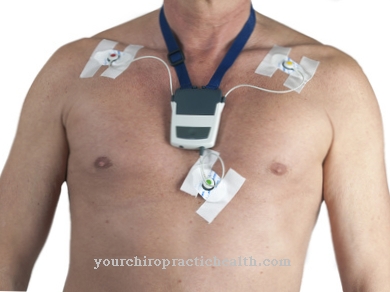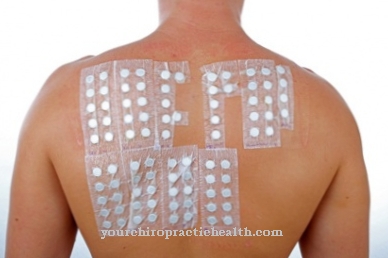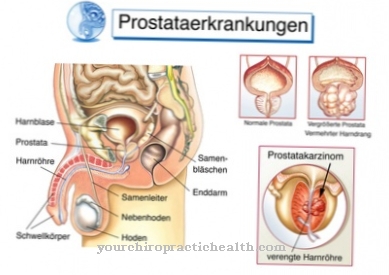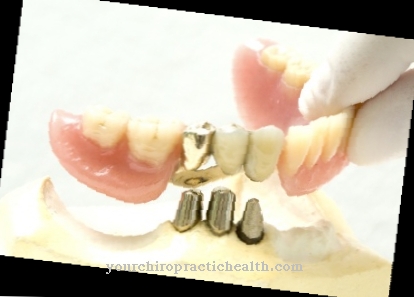In the Tonometry it is a diagnostic measurement method in ophthalmology (ophthalmology). The intraocular pressure is determined with special devices. An increase in this value can indicate the presence of glaucoma, or glaucoma.
What is tonometry?

In ophthalmological diagnostics, intraocular pressure is an important distinguishing feature of glaucoma. Intraocular pressure is created by the aqueous humor, which supplies the cornea with nutrients. The aqueous humor flows into the anterior chamber of the eye and from there into the bloodstream. The inflow and outflow of aqueous humor are balanced in a healthy eye.
If there are imbalances, the intraocular pressure increases. In healthy adults, the intraocular pressure is between 10 and 21 mmHg (millimeter mercury). However, these values vary depending on the time of day, age and body position of the patient. In order to achieve really meaningful values, the intraocular pressure measurement is carried out at different times. The results are summarized in a daily profile. Tonometry is an important tool for recognizing glaucoma in good time, as this disease develops insidiously and does not cause any pain in the early stages.
The diagnostic procedure is also used to monitor the progress of glaucoma. The high pressure values damage the optic nerve and in the worst case lead to blindness in the patient. Defects in the field of vision are typical symptoms of glaucoma, such as a gray spot that moves into the field of vision. Or a narrowing of the field of view running from the outside in.
Diabetics and people with age-related macular degeneration are among the risk groups for this disease, as are people with myopia and farsightedness. Ophthalmologists therefore recommend tonometry every two years from the age of 40. An annual check-up is recommended for familial occurrences of glaucoma.
Function, effect & goals
There are several measuring methods available for tonometry, but not all of them with reliable results. The Goldmann applanation tonometer is used most frequently. The examination is carried out lying down or sitting. Local anesthesia of the cornea, which is carried out using eye drops, is required for the examination. Then the cornea is carefully pressed in with a small, cylindrical measuring device, the tonometer.
The pressure exerted in this way is measured in mmHg and gives the current intraocular pressure value. The more force the ophthalmologist needs to press the tonometer, the higher the internal pressure in the eye. Advantage of the Goldmann tonometer: It can be attached to the slit lamp, the examination microscope of the ophthalmologist. Non-contact tonometry manages without corneal contact. No anesthetic drops are necessary. Here the cornea is pressed in by means of an air pulse. The deformation of the cornea is then measured. However, this method is rarely used because the measured values are not precise enough.
This also applies to impression tonometry, an older method in which a metal pen is used to measure. Here again an anesthetic is required. A pen is then sunk into the cornea and the doctor measures how deep the pen indented the cornea. A relative novelty in ophthalmology is dynamic contour tonometry. This means that the ophthalmologist has a very precise measuring instrument at hand. Similar to an EKG, it is thus possible to display pulse curves of the eye pressure triggered by the heartbeat. A pressure sensor in the tonometer head can measure the intraocular pressure regardless of corneal influences - whether thick, thin, curved or straight.
This method is increasingly used because of its accuracy. In addition to the existing investigation options, some measurement methods are still in the testing stage. One of them is the pressure sensitive contact lens. The patient should wear this for several hours so that the intraocular pressure and its fluctuations can be measured over longer periods of time. Doctors hope that this will be a major step forward and patients will find it easier to make a diagnosis. After all, once glaucoma has developed, damage to the optic nerve that has already occurred is usually irreversible.
The most important measure is now to lower the intraocular pressure. A whole range of eye drops are available for this. Regularly check with the tonometer whether the pressure could be reduced sustainably. If the drops have no or insufficient effect, glaucoma surgery may be necessary to improve the drainage of the aqueous humor.
You can find your medication here
➔ Medicines for eye infectionsRisks, side effects & dangers
The risks of tonometry are low and complications are rare. Only with the applanation tonometry according to Goldmann is there a risk of injury, albeit a small one. It is therefore advisable for patients to look for an ophthalmologist with appropriate experience in this diagnosis.
Since the tonometer is placed directly on the cornea, germ transmission is also conceivable. However, meticulous disinfection should prevent this. Even if tonometry is the method of choice for clarifying glaucoma, it is not part of the preventive care catalog. The statutory health insurance companies do not cover the costs. Tonometry is one of the IGeL services. The patient has to reckon with around 20 euros. It is different if there are urgent suspicions or an increased risk of cataracts. Then the health insurers will also cover the costs for a tonometry.
After the glaucoma diagnosis has been made, the health insurance companies bear all further treatment expenses. The applanation tonometry can and must only be performed by ophthalmologists, as anesthetic eye drops must be administered. With non-contact tonometry, however, this is not necessary. Therefore, opticians are now increasingly offering this examination method. But here, too, the following applies: No cost coverage by the health insurers.













.jpg)

.jpg)
.jpg)











.jpg)